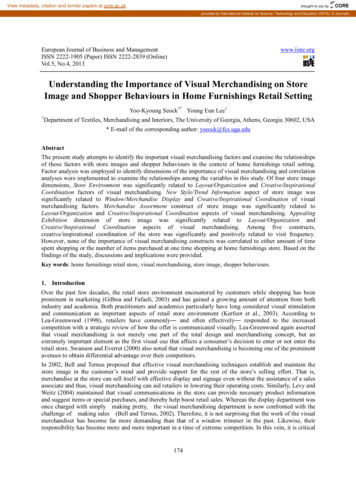
Transcription
Chapter 04 – Accounting for Merchandising OperationsChapter 4Accounting for Merchandising OperationsQUESTIONS1.Additional accounts of a merchandising company likely include Merchandise Inventory,Sales (of goods), Cost of Goods Sold, Sales Discounts, and Sales Returns andAllowances (and possibly Delivery Expense).2.Merchandising companies report Merchandise Inventory on the balance sheet, servicecompanies do not. Also, merchandising companies report both Sales (of goods) andCost of Goods Sold on the income statement, while service companies do not.3.A company can have a net loss if its expenses (absent cost of goods sold) are greaterthan its gross profit from sales of merchandise.4.A cash discount can be offered to encourage customers to promptly pay. This providescash more quickly to the seller and avoids the costs of additional collection activities.Of course, the seller must perform a costs vs. benefits analysis on the merits and termsof any cash discount offered to customers.5.For a perpetual inventory system, inventory shrinkage is determined by taking aphysical count of the inventory available at the end of a period and comparing thatamount with the amount recorded in the Merchandise Inventory account.6.Cash discounts are granted in return for early payment and reduce the amount paidbelow the negotiated price. Cash discounts are recorded in the accounting records (asa reduction of Merchandise Inventory). Trade discounts are deducted from the list orcatalog price to determine the purchase (negotiated) price. Trade discounts are notrecorded in the accounting records.7.Sales discount is a term used by a seller to describe a cash discount granted to acustomer. Purchase discount is a term used by a purchaser to describe a cashdiscount received from a seller. (It is a matter of perspective: seller versus buyer.)8.A manager is concerned about the quantity of its purchase returns because thecompany incurs costs in receiving, inspecting, identifying, and returning themerchandise. More returns create more expenses. By knowing more about returns,the manager can decide if they are a problem and how they can be minimized.9.The sender (maker) of a debit memorandum records a debit in an account of therecipient; and the recipient records a credit in an account maintained for the sender.4-1
Chapter 04 – Accounting for Merchandising Operations10. The single-step income statement format presents cost of goods sold and expenses inone list, totals the list, and subtracts the total from net sales in one step. The multiplestep format presents intermediate totals, including gross profit (the difference betweennet sales and cost of goods sold) and sub-categories of expenses (often by keyactivities).11. Research In Motion calls its inventory account “Inventories.” A detailed calculation ofcost of sales is not presented by RIM. However, Research In Motion presents Cost ofSales separate for “Devices and other” and “Service and software.”12. Nokia titles its cost of goods sold account “Cost of sales.”13. Apple titles its cost of goods sold account “Cost of sales.”14. Palm reports a separate gross margin figure on its consolidated statement of income.Its 2009 gross profit is 159,759 (in thousands).15. A buyer should attempt to negotiate the shipping terms FOB destination. In this case,title will pass after the goods are safely delivered to the buyer’s business andtransportation charges will be the responsibility of the supplier (seller).QUICK STUDIESQuick Study 4-1 (10 uick Study 4-2 (5 minutes)Answer: e4-2
Chapter 04 – Accounting for Merchandising OperationsQuick Study 4-3 (15 minutes)Mar. 5 Merchandise Inventory .Accounts Payable .2,5002,500To record credit purchase [500 x 5].Mar. 7 Accounts Payable .Merchandise Inventory .250250Returned defective units[(50/500) x 2,500] or [50 x 5].Mar. 15 Accounts Payable .Cash .Merchandise Inventory .2,2502,20545Paid for purchase less cash discount[ 2,250 - ( 2,250 x 2%)].Quick Study 4-4 (10 minutes)Apr. 1 Accounts Receivable .Sales .2,0002,000To record credit sale.1 Cost of Goods Sold .Merchandise Inventory .1,4001,400To record cost of credit sale.4 Sales Returns and Allowances .Accounts Receivable .500500To record sales return.4 Merchandise Inventory .Cost of Goods Sold .350350Restore cost of returned goods to inventory.11 Cash .Sales Discounts .Accounts Receivable .Received payment less cash discount[( 2,000 - 500) x 98%].4-31,470301,500
Chapter 04 – Accounting for Merchandising OperationsQuick Study 4-5 (10 minutes)(a)Sales . 130,000Sales discounts . (4,200)Sales returns and allowances . (17,000)Net sales . 108,800Cost of goods sold . (76,600)Gross profit . 32,200Gross margin ratio:(Gross profit / Net sales) .29.6%(b) 512,000(16,500)(5,000)490,500(326,700) 163,800(c) 35,700(400)(5,000)30,300(21,300) 9,000(d) 245,700(3,500)(700)241,500(125,900) 115,60033.4%29.7%47.9%Interpretation of gross margin ratio for case a: The ratio of 29.6% shows thatfor each dollar in net sales the company earns 29.6 cents in gross profit. Thecompany must still make deductions for other expenses that it incurs inrunning the business when computing net income.Quick Study 4-6 (10 minutes)July 31 Cost of Goods Sold .Merchandise Inventory .1,9001,900To adjust for shrinkage based onphysical count [ 34,800 - 32,900].Quick Study 4-7 (10 minutes)July 31 Sales . 157,200Income Summary .157,200To close temporary accounts with credit balances.July 31 Income Summary . 147,900Sales Discounts .Sales Returns and Allowances .Cost of Goods Sold* .Depreciation Expense .Salaries Expense .Miscellaneous Expenses .To close temporary accounts with debitbalances. (* 102,000 1,900 — from QS 4-6)4-41,7003,500103,9007,30029,5002,000
Chapter 04 – Accounting for Merchandising OperationsQuick Study 4-8 (10 minutes)Acid-test ratio ( 1,200 2,700) / ( 4,750 950) 0.68Explanation of acid-test ratio: The acid-test ratio is used to evaluate (reflect on)the liquidity of a company. It helps in determining whether a company will beable to meet its current obligations as they come due with its most liquid assets.In this case, the company only has 68 cents available in quick assets to pay 1.00 in current liabilities as they come due. An acid-test ratio less than oneusually suggests some concern and encourages further analysis of liquidity.Quick Study 4-9 (10 minutes)Similarities: Both the acid-test ratio and current ratio are used to assessliquidity. Both ratios are computed with current liabilities as the denominator.Differences: The current ratio includes all current assets in the numerator. Theacid-test ratio includes current assets less inventories and prepaids in itsnumerator (leaving cash & equivalents, current receivables, and short-terminvestments).Comparison and Description: Compared with the current ratio, the acid-testratio is a more stringent test of a company’s ability to meet its currentobligations. The acid-test ratio is more stringent as it does not assume acompany relies on prepaids and inventory to pay current liabilities. This isbecause prepaids and inventory assets are not generally available to satisfycurrent obligations.Quick Study 4-10 (10 minutes)Answer: eQuick Study 4-11A (5 minutes)a.b.c.d.e.Perpetual inventory systemPerpetual inventory systemPerpetual inventory systemPerpetual inventory systemPeriodic inventory system4-5
Chapter 04 – Accounting for Merchandising OperationsProblem 4-4A (Continued)3. Multiple-step income statementBIZKID COMPANYIncome StatementFor Year Ended August 31, 2011Sales.Less: Sales discounts . 3,250Sales returns and allowances . 14,000Net sales .Cost of goods sold * .Gross profit .ExpensesSelling expensesSales salaries expense . 29,000Rent expense—Selling space . 10,000Store supplies expense .2,500Advertising expense . 18,000Total selling expenses .General and administrative expensesOffice salaries expense .Rent expense—Office space .Office supplies expense .Total general and administrative expensesTotal expenses .Net 800*Cost of goods sold (alternative computation):Merchandise inventory, August 31, 2010 . 25,000Total cost of merchandise purchased (from part 2) .88,600Merchandise available for sale . 113,600Merchandise inventory, August 31, 2011 .31,000Cost of goods sold .82,6004-32 212,00029,90089,400 22,750
Chapter 04 – Accounting for Merchandising OperationsProblem 4-4A (Concluded)4. Single-step income statementBIZKID COMPANYIncome StatementFor Year Ended August 31, 2011Net sales . 194,750ExpensesCost of goods sold . 82,600Selling expenses .General and administrative expenses .Total expenses .Net income.4-3359,50029,900172,000 22,750
Chapter 04 – Accounting for Merchandising OperationsProblem 4-5A (30 minutes)Part 1Closing entries:Aug. 31 Sales . 212,000Income Summary .212,000To close temporary accounts with creditbalances.Aug. 31 Income Summary . 189,250Sales Discounts .Sales Returns and Allowances .Cost of Goods Sold .Sales Salaries Expense .Rent Expense—Selling Space .Store Supplies Expense .Advertising Expense .Office Salaries Expense .Rent Expense—Office Space .Office Supplies Expense 00800To close temporary accounts with debitbalances.Aug. 31 Income Summary .Retained Earnings .22,75022,750To close the Income Summary account.Aug. 31 Retained Earnings .Dividends .To close the dividends account.4-348,0008,000
Chapter 04 – Accounting for Merchandising OperationsProblem 4-5A (Concluded)Part 2The first step is to determine the amount of purchases that are subject to adiscount during the year:Invoice cost of merchandise purchases . 91,000Purchase returns and allowances .(4,400)Total cost of merchandise payable . 86,600This amount is used to determine the maximum discount, which is thencompared to the actual discount:Maximum discount available (3% x 86,600) . 2,598Purchase discounts received .(1,900)Purchase discounts missed . 698As a percent of available discounts ( 698/ 2,598) .26.9%This analysis suggests that nearly 27% of available discounts have beenmissed. As a result, it would appear that cash is not being well managed.Management should try to identify a better system for ensuring that allfavorable discounts are taken. It is possible that the discounts not taken areactually not favorable to the company—further information is required toassess this possibility.Part 3The first step is to compute this year’s sales returns and allowances rate:Sales.Sales returns and allowances . 212,000 14,000Percent of returns and allowances to sales .6.6%This calculation shows that the company’s customers are returning orrequiring allowances on items at a higher rate than the 5% rate observed inprior years. It appears that management should investigate the situation tosee why there are more dissatisfied customers this year than in prior years.4-35
Chapter 04 – Accounting for Merchandising OperationsEthics Challenge, BTN 4-3 — (Concluded)2. The merchandising company accounts for sales returns using a contrarevenue account called Sales Returns and Allowances.A dressreturned with a sales bill of 200 would be accounted for as follows:Sales Returns and Allowances .Accounts Receivable .200200Also, if the item is returned to inventory (and it had cost 160), thefollowing entry is made:Merchandise Inventory .Cost of Goods sold .Communicating in Practice160160— BTN 4-4Note: While responses will vary, the essence of its content follows:TO:Mr. J. MadsenFROM:DATE:SUBJECT: Reply to inventory shrinkage questionYou are correct in noting that Music Plus has lost inventory as a result ofshoplifting and other forms of shrinkage. However, you will be pleased toknow your investment in security has paid off. Let me explain.We maintain a perpetual inventory system, which continuously updatesinventory account balances as goods are purchased, sold, and returned.At the end of each accounting period, we take an actual physical inventoryand compare this amount to our inventory records. These accountingprocedures for verifying inventory available have disclosed that theamount of inventory loss is not abnormally large. Accounting proceduresallow this immaterial shrinkage to be directly charged to cost of goodssold. This is why you do not see a specific deduction for shrinkage on theincome statement. Instead, the deduction has been taken in the form ofincreased cost of goods sold.I hope this addresses your concern and that you are now confident that netincome is not overstated. If you have any additional questions or requiremore specific information regarding inventory shrinkage, please let meknow. The supporting information is available in the accounting records.4-64
Chapter 04 – Accounting for Merchandising OperationsTaking It to the NetFiscal Year ( thousands)2008— BTN 4-520092010Net sales . 1,334,723 1,427,970 1,578,042Cost of goods sold .746,180872,547882,385Gross margin . 588,543 555,423 695,657Gross margin ratio .44.1%38.9%44.1%Analysis: J. Crew’s gross margin ratio declined from 44.1% in 2008 to38.9% in 2009, but then rebounded to 44.1% in 2010. Its net salesincreased in both 2009 and 2010, albeit with a lower gross margin for the2009 recessionary period.4-65
Chapter 04 – Accounting for Merchandising OperationsTeamwork in Action— BTN 4-61.a. Net sales computation:Sales .Less: Sales discounts .Sales returns and allowances .Net sales . 430,000 6,60018,000b. Total cost of merchandise purchases computation:Invoice cost of merchandise purchases .Less: Purchase discounts received .Purchase returns and allowances .Add costs of transportation-in .Total cost of merchandise purchases .c. Cost of goods sold computation:Merchandise inventory, Beginning.Total cost of merchandise purchased (from b) .Merchandise available for sale .Merchandise inventory, Ending .Cost of goods sold .24,600 405,400 180,000(4,500)(5,500)11,000 181,000 49,000181,000 230,000(42,000) 188,000d. Gross profit computation:Net sales (from a) .Less: Cost of goods sold (from c) .Gross profit . 405,400188,000 217,400e. Net income computation:Gross profit from sales (from d) .Operating expenses (given) .Net income . 217,40020,000 197,4002. Net income is 197,400.3. The inventory account balance is 42,000. If actual (physical) inventoryis 38,000, a 4,000 loss from inventory shrinkage occurred. Thiswould result in an adjustment necessitating a reduction (credit) to theinventory account and an increase (debit) to cost of goods sold. This 4,000 increase in cost of goods sold would result in a correspondingdecrease in both gross profit and net income. This means that netincome would decline to 193,400.4-66
Chapter 04 – Accounting for Merchandising OperationsEntrepreneurial Decision— BTN 4-71.Heritage Link BrandsForecasted Income StatementFor Year Ended January 31, 2011Net sales ( 10,000,000 x 1.09) .Cost of sales* ( 10,900,000 x 61%) .Expenses ( 2,000,000 x 1.06) .Net income . 10,900,0006,649,0002,120,000 2,131,000* Gross profit ratio ( 10,000,000 - 6,100,000) / 10,000,000 39%; therefore the ratio ofcost of sales to sales 100% - 39% 61%2. The proposal yields a forecasted net income of 2,131,000. This comparesfavorably to the prior year’s net income of 1,900,000. Accordingly, basedon these facts alone, the company should implement the proposal.3. There are many issues that should be considered. Among them are: First, there is the issue of the prediction itself. That is, are estimatesreasonable or could reality be markedly different from these estimates? Second, and related to the first, there is a need to consider “ranges” ofpossible scenarios since the future is unpredictable. This would involvelooking at alternative possibilities and then assessing the range ofoutcomes. Third, there is a concern with the impact of these changes on customerattitudes. For example, one concern might be with the proposed changeto an FOB shipping point policy from FOB destination. We need to becertain that our customers will not object to this change and lookelsewhere for their merchandise. In addition to issues of confidence in prediction, one should alsoconsider that there may be speeding up of cash collections. Customersnow have 15 days to earn a 1% discount. By changing the terms,customers will have only 10 days to earn a 3% discount. That additionaldiscount may motivate some customers to pay sooner. Currently, the company sends a signal to customers through terms ofn/60 that it is willing to wait 60 days for payment. By changing the termsto n/30, the company signals that it is now only willing to wait 30 daysbefore payments are overdue. This may motivate customers to paysooner.In sum, we must consider alternative possibilities, both good and bad,with these proposed policy changes.4-67
Chapter 04 – Accounting for Merchandising OperationsHitting the Road— BTN 4-8There is no formal solution for this field activity. As the discussionfacilitator, the instructor should try to develop a sense of how willing retailmanagers are in granting sales allowances, the range of return policiesemployed, and strategies managers use to stem return abuses.Global Decision— BTN 4-91.(in millions)NokiaRevenues .40,984ResearchIn Motion 14,953 42,905Cost of sales.27,7208,36925,683Gross margin.13,264 6,584 17,222Gross margin ratio .32.4%44.0%40.1%Gross Margin %Research In Motion .44.0%AppleRank1Apple .40.1%2Nokia .32.4%32. Research In Motion, Apple, and Nokia each use the multiple-step formatfor their income statements. Nokia’s income statement is somewhatdifferent from what most U.S. companies use in that the term profit isused instead of net income, the title “finance expenses” is used insteadof interest expense, and they report in EUR instead of dollars.4-68
Chapter 04 - Accounting for Merchandising Operations 4-64 Ethics Challenge, BTN 4-3 —(Concluded) 2. The merchandising company accounts for sales returns using a contra revenue account called Sales Returns and Allowances. A dress returned with a sales bill of 200 would be accounted for as follows:










